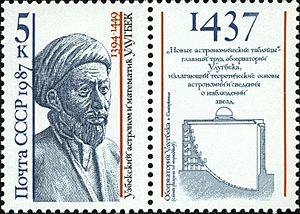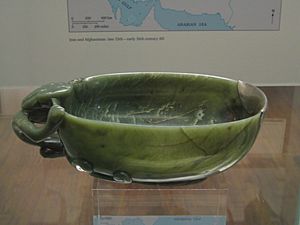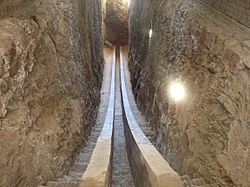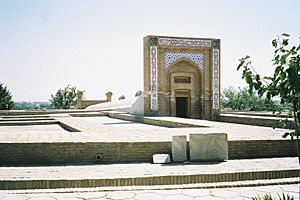Ulugh Beg facts for kids
Quick facts for kids Ulugh Beg |
|
|---|---|
| Mirza (royal rank) | |

Ulugh Beg's Statue in Samarkand, Uzbekistan
|
|
| Reign | 1447–1449 |
| Predecessor | Shahrukh Mirza |
| Successor | Abdal-Latif Mirza |
| Born | Mirza Muhammad Taraghay 22 March 1394 Sultaniyeh, Timurid Empire, Persia, now Zanjan Province, Iran |
| Died | 27 October 1449 (aged 55) Samarkand, Timurid Empire, now Samarqand Region, Uzbekistan |
| Burial | Gur-e-Amir Samarkand in the Mausoleum of Timur |
| Spouse | Aka Begi Begum Sultan Badi al-mulk Begum Aqi Sultan Khanika Husn Nigar Khanika Shukur Bi Khanika Rukaiya Sultan Agha Mihr Sultan Agha Sa'adat Bakht Agha Daulat Sultan Agha Bakhti Bi Agha Daulat Bakht Agha Sultanim Agha Sultan Malik Agha |
| Issue | Abdal-Latif Mirza |
| Father | Shahrukh Mirza |
| Mother | Goharshad Begum |
| Religion | Islam |
| Occupation | astronomer, mathematician and sultan |
Mīrzā Muhammad Tāraghay bin Shāhrukh (March 22, 1394 in Sultaniyeh, Persia – October 27, 1449, Samarkand, Uzbekistan), was a Timurid Sultan as well as an astronomer and mathematician.
Ulugh Beg was notable for his work in astronomy-related mathematics, such as trigonometry and spherical geometry, as well as his general interests in the arts and intellectual activities. It is thought that he spoke five languages: Arabic, Persian, Turkic, Mongolian, and a small amount of Chinese. During his rule (first as a governor, then outright) the Timurid Empire achieved its cultural peak through Ulugh Beg's attention and patronage. Samarkand, which was captured and given to Ulugh Beg by his father Shah Rukh, became the headquarters of Muslim culture.
He built the great Ulugh Beg Observatory in Samarkand between 1424 and 1429. It was considered by scholars to have been one of the finest observatories in the Islamic world at the time and the largest in Central Asia. Ulugh Beg was subsequently recognized as the most important observational astronomer from the 15th century by many scholars. He also built the Ulugh Beg Madrasah (1417–1420) in Samarkand and Bukhara, transforming the cities into cultural centers of learning in Central Asia.
However, Ulugh Beg's scientific expertise was not matched by his skills in governance. During his short reign, he failed to establish his power and authority. As a result, other rulers, including his family, took advantage of his lack of control and he was subsequently overthrown and assassinated.
Contents
Early life
He was a grandson of the great conqueror, Timur (Tamerlane) (1336–1405), and the oldest son of Shah Rukh, both of whom came from the Turkicized Barlas tribe of Transoxiana (now Uzbekistan). His mother was a noblewoman named Goharshad, daughter of a member of the representative Turkic tribal aristocracy, Ghiyasuddin Tarkhan. Ulugh Beg was born in Sultaniyeh in Persia during Timur's invasion.
His was given the name Mīrzā Muhammad Tāraghay. Ulugh Beg, the name he most commonly known by, was not truly a personal name, but rather a moniker, which can be loosely translated as "Great Ruler" (compare modern Turkish ulu, "great", and bey, "chief") and is the Turkic equivalent of Timur's Perso-Arabic title Amīr-e Kabīr.
As a child he wandered through a substantial part of the Middle East and India as his grandfather expanded his conquests in those areas. After Timur's death, Shah Rukh moved the empire's capital to Herat (in modern Afghanistan). Sixteen-year-old Ulugh Beg subsequently became the governor of the former capital of Samarkand in 1409. In 1411, he was named the sovereign ruler of the whole of Mavarannahr.
Science
He was also famous in the fields of medicine and poetry. He used to debate with other poets about contemporary social issues. He liked to debate in a poetic style, called "Bahribayt" among local poets. According to the Russian medical book "Mashkovskiy", Ulugh Beg discovered a mixture of alcohol with garlic, apparently preserving it to help treat conditions like diarrhea, headache, stomach ache and intestine illnesses. He also offered advice for newly married couples, which indicate recipes containing nuts, dried apricot, dried grape etc. He claimed these to be useful to increase men's virility. This recipe has been given in Ibn Sina's books also.
Astronomy
From an early age, astronomy piqued his interest after he paid a visit to what was still present of the Maragheh Observatory located in Maragheh, Iran. This is the observatory where the well-known astronomer Nasir al-Din al-Tusi practiced.
In 1428, Ulugh Beg built an enormous observatory, called the Gurkhani Zij.
Lacking telescopes to work with, he increased his accuracy by increasing the length of his sextant; the so-called Fakhri sextant had a radius of about 36 meters (118 feet) and the optical separability of 180" (seconds of arc). The Fakhri sextant was the largest instrument at the observatory in Samarkand (an image of the sextant is on the side of this article).
There were many other astronomical instruments located at the observatory, but the Fakhri sextant is the most well-known instrument there. The purpose of the Fakhri sextant was to measure the transit altitudes of the stars. This was a measurement of the maximum altitude above the horizon of the stars. It was only possible to use this device to measure the decline of natural objects in space.
With the instruments located in the observatory in Samarkand, Ulugh Beg composed a star catalogue consisting of 1018 stars, which is eleven less stars than are present in the star catalogue of Ptolemy.
In 1437, Ulugh Beg determined the length of the sidereal year as 365.2570370...d = 365d 6h 10m 8s (an error of +58 seconds). In his measurements over the course of many years he used a 50 m high gnomon. This value was improved by 28 seconds in 1525 by Nicolaus Copernicus, who appealed to the estimation of Thabit ibn Qurra (826–901), which had an error of +2 seconds. However, Ulugh Beg later measured another more precise value of tropical year as 365d 5h 49m 15s, which has an error of +25 seconds, making it more accurate than Copernicus's estimate which had an error of +30 seconds.
Ulugh Beg also determined the Earth's axial tilt as 23°30'17" in the sexagesimal system of degrees, minutes and seconds of arc, which in decimal notation converts to 23.5047 degrees.
Mathematics
In mathematics, Ulugh Beg wrote accurate trigonometric tables of sine and tangent values correct to at least eight decimal places.
War of succession and death
In 1447, upon learning of the death of his father Shah Rukh, Ulugh Beg went to Balkh. Here, he heard that Ala-ud-Daulah Mirza, the son of his late brother Baysonqor, had claimed the rulership of the Timurid Empire in Herat. Consequently, Ulugh Beg marched against Ala-ud-Daulah and met him in battle at Murghab. He defeated his nephew and advanced toward Herat, massacring its people in 1448. However, Abul-Qasim Babur Mirza, Ala-ud-Daulah's brother, came to the latter's aid and defeated Ulugh Beg.
Ulugh Beg retreated to Balkh, where he found that its governor, his oldest son Abdal-Latif Mirza, had rebelled against him. Another civil war ensued. Abdal-Latif recruited troops to meet his father's army on the banks of the Amu Darya river. However, Ulugh Beg was forced to retreat to Samarkand before any fighting took place, having heard news of turmoil in the city. Abdal-Latif soon reached Samarkand and Ulugh Beg involuntarily surrendered to his son. Abd-al-Latif released his father from custody, allowing him to make pilgrimage to Mecca. However he ensured Ulugh Beg never reached his destination, having him, as well as his brother Abdal-Aziz assassinated in 1449.
Eventually, Ulugh Beg's reputation was rehabilitated by his nephew, Abdallah Mirza (1450–1451), who placed his remains in the mausoleum of Timur in Samarkand, where they were found by Soviet archeologists in 1941.
Marriages
Ulugh Beg had thirteen wives:
- Aka Begi Begum, daughter of Muhammad Sultan Mirza bin Jahangir Mirza and Khan Sultan Khanika, mother of Habiba Sultan known as Khanzada Begum and another Khanzada Begum;
- Sultan Badi al-mulk Begum, daughter of Khalil Sultan bin Miran Shah and Shad Malik Agha;
- Aqi Sultan Khanika, daughter of Sultan Mahmud Khan Ogeday;
- Husn Nigar Khanika, daughter of Shams-i-Jahan Khan Chaghatay;
- Shukur Bi Khanika, daughter of Darwish Khan Jochi;
- Rukaiya Sultan Agha, an Arlat lady, and mother of Abdal-Latif Mirza, Ak Bash Begum and Sultan Bakht Begum;
- Mihr Sultan Agha, daughter of Tukal bin Sarbuka;
- Sa'adat Bakht Agha, daughter of Bayan Kukaltash, mother of Qutlugh Turkhan Agha;
- Daulat Sultan Agha, daughter of Khawand Sa'id;
- Bakhti Bi Agha, daughter of Aka Sufi Uzbek;
- Daulat Bakht Agha, daughter of Sheikh Muhammad Barlas;
- Sultanim Agha, mother of Abdul Hamid Mirza and Abdul Jabrar Mirza;
- Sultan Malik Agha, daughter of Nasir-al-Din, mother of Ubaydullah Mirza, Abdullah Mirza and another Abdullah Mirza;

Legacy
- The crater, Ulugh Beigh, on the Moon, was named after him by the German astronomer Johann Heinrich von Mädler on his 1830 map of the Moon.
- 2439 Ulugbek, a main-belt asteroid which was discovered on 21 August 1977 by N. Chernykh at Nauchnyj, was named after him.
Exhumation
Soviet anthropologist Mikhail M. Gerasimov reconstructed the face of Ulugh Beg. Like his grandfather Timurlane, Ulugh Beg is close to the Mongoloid type with slightly Europoid features. His father Shah Rukh, had predominantly Caucasoid features, with no obvious Mongoloid feature.
See also
 In Spanish: Ulugh Beg para niños
In Spanish: Ulugh Beg para niños




